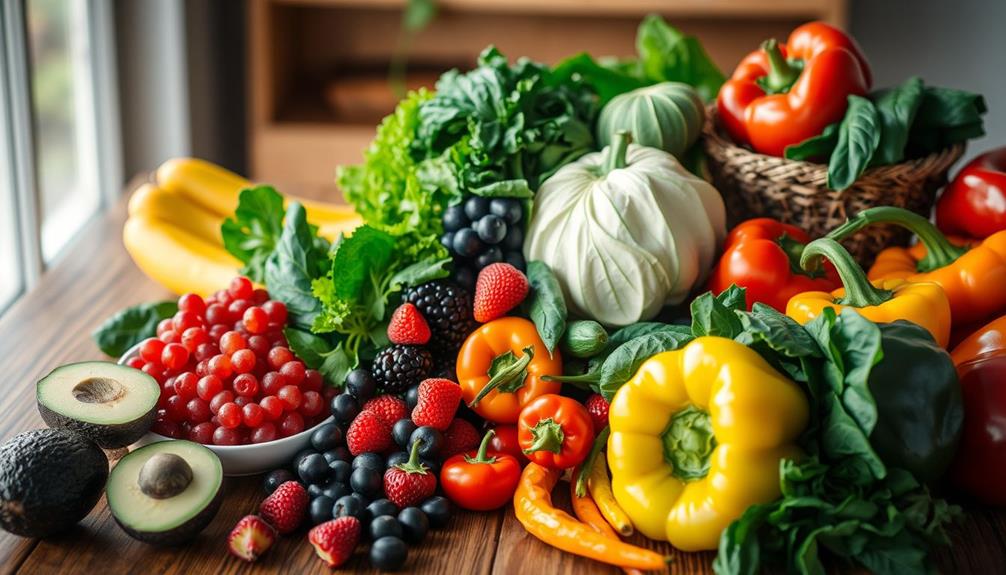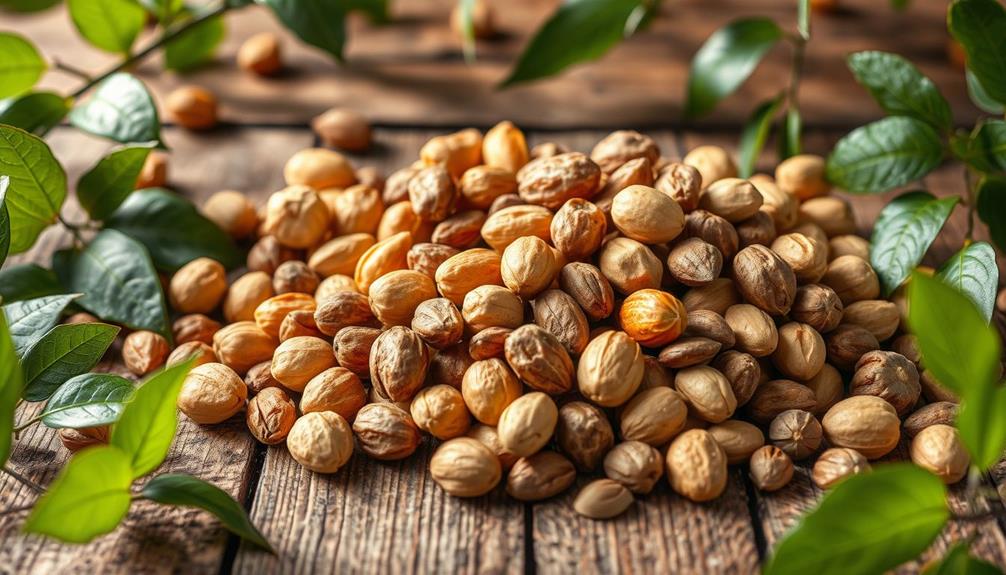Peanut butter isn't considered a raw food, especially if it's made from roasted peanuts. The roasting process heats the peanuts above 350°F, altering their nutritional value and disqualifying them from strict raw food diets. If you want a raw option, you can make homemade peanut butter from quality, raw peanuts, but sourcing these can be tricky due to contamination risks, like aflatoxins. While peanut butter has its perks, alternatives like raw almond or cashew butter might be safer. Stick around to explore more about sourcing and enjoying your nut butters without compromising your raw food goals.
Key Takeaways
- Most commercial peanut butter is made from roasted peanuts, making it not raw due to high-temperature processing.
- Raw peanuts pose health risks, including aflatoxin contamination, which can lead to severe liver damage.
- Homemade raw peanut butter can be made, but sourcing quality raw peanuts is challenging and requires caution.
- Alternatives like raw cashew or almond butter can provide safer options with similar nutritional benefits.
- Nutritional benefits of raw foods include higher nutrient density, antioxidants, and dietary fiber, supporting overall health.
Overview of Raw Food Diet
The raw food diet is all about embracing unprocessed, whole foods that keep their natural nutrients intact. This approach primarily focuses on consuming raw fruits, vegetables, nuts, seeds, and sprouted grains. By not heating foods above 104-118°F (40-48°C), you preserve essential nutrients and enzymes believed to provide numerous health benefits. Incorporating essential oils for health can further enhance your wellness journey.
While many adherents primarily enjoy plant-based foods, some variations may include raw animal products like eggs, dairy, or fish.
A balanced raw food diet can lead to significant advantages, such as improved digestion, weight loss, and a reduced risk of chronic diseases. However, achieving this balance requires careful planning to avoid nutrient deficiencies. For example, incorporating raw peanuts can add valuable protein and healthy fats to your meals.
Preparation techniques in the raw food diet include juicing, blending, soaking, dehydrating, and sprouting, all of which enhance both flavor and the shelf life of your ingredients.
Peanut Butter Processing Explained

Processing peanut butter involves a series of meticulous steps that transform raw peanuts into the creamy spread many enjoy. It starts with harvesting the peanuts, followed by de-shelling, roasting, skinning, and sorting the nuts. The roasting process typically heats peanuts above 350°F, which considerably alters their raw food status.
Proper care and feeding of the peanuts before processing can impact the final product's quality, similar to how ultimate hamster care guarantees a healthy pet. After roasting, the peanuts are pulverized into a spreadable form, creating the peanut butter you find in stores.
However, most commercial peanut butters are highly processed and often contain added oils, salt, and sugar. These ingredients not only enhance flavor but also diminish the nutritional value of the product. In the raw food community, such processed foods aren't considered "living" foods, as they lose essential nutrients and enzymes during processing.
If you're seeking a more natural option, homemade peanut butter can be a great alternative. You can easily make it using high-speed blenders or food processors, although sourcing quality raw peanuts can be challenging due to contamination risks.
Is Peanut Butter Truly Raw?

When it comes to peanut butter, many people wonder if it can truly be classified as raw. Most commercial peanut butter is made from roasted peanuts, which undergo high-temperature processing that exceeds the raw food temperature guidelines of 104-118°F (40-48°C). This means that typical peanut butter you find in stores isn't raw, and it alters its nutritional value.
Additionally, it's essential to acknowledge that raw peanuts may carry health risks due to potential contamination, similar to the concerns surrounding certain medications and their interactions with food.
If you're looking for raw peanut butter, you can make it at home using high-speed blenders or food processors. However, you'll need to source high-quality raw peanuts, which come with their own set of challenges. It's vital to confirm these peanuts are free from contamination risks, like aflatoxins, as consuming raw peanuts can pose health risks due to potential exposure to harmful toxins.
While raw peanut butter might seem appealing, the nutritional value can diminish due to sourcing difficulties, short shelf life, and rapid rancidity of raw peanuts.
If you're following a raw food diet, consider alternatives like raw cashew, almond butter, or tahini, which offer safer production methods and better nutritional benefits.
Health Risks of Raw Peanuts

When you consider eating raw peanuts, be aware of the health risks involved. Aflatoxin contamination is a serious concern, especially since raw peanuts have a short shelf life that can lead to spoilage.
Additionally, the potential for exposure to harmful substances makes it vital to understand the importance of selecting safe food options, as highlighted in cold medication recommendations.
Plus, sourcing these nuts safely can be challenging, putting you at greater risk for toxin exposure.
Aflatoxin Contamination Risks
Aflatoxin contamination poses substantial health risks to those who consume raw peanuts. These toxic compounds, produced by the mold Aspergillus flavus, can lead to severe liver damage and increase the risk of liver cancer. That's why it's imperative for you to source high-quality raw peanuts carefully.
The risk of aflatoxin contamination is particularly high in warm, humid climates where peanuts thrive, making stringent quality control critical. Additionally, understanding the importance of financial health can promote informed purchasing decisions, including selecting safe food products.
When you eat contaminated raw peanuts regularly, you might experience acute aflatoxicosis, which comes with unpleasant symptoms like nausea, vomiting, and abdominal pain. Proper storage is essential to minimize your exposure.
Raw peanuts have a shorter shelf life due to their susceptibility to rancidity and mold growth. If they're not stored correctly, the risk of aflatoxin exposure considerably increases.
To protect your health, always check for reliable sources and verify that the raw peanuts you consume are stored in cool, dry conditions. Additionally, consider roasting raw peanuts to eliminate the risk of aflatoxin contamination, as the heat can break down these harmful compounds.
Being informed about these risks is critical for safe consumption.
Short Shelf Life
Raw peanuts come with a markedly short shelf life, typically lasting only a few months. This isn't just about freshness; it's also about health risks. The susceptibility of raw peanuts to rancidity and spoilage can lead to significant issues, especially if they're not sourced from reliable suppliers.
Individuals with Borderline Personality Disorder (BPD) may experience intense emotional responses to food-related choices, which could be exacerbated by the consumption of rancid peanuts, leading to increased anxiety or distress emotional dysregulation.
Here are a few things to keep in mind:
- Regularly check your peanuts for signs of spoilage.
- Store them in cool, dark places to maximize their shelf life.
- Be aware of the risk of aflatoxins, which can develop if peanuts are contaminated.
Consuming rancid or contaminated raw peanuts can result in digestive issues and even toxic effects, making quality sourcing paramount. The risk of foodborne illness also increases with raw peanuts, as they can be contaminated during harvesting or processing.
You should handle and prepare them with care. By being mindful of these factors, you can enjoy raw peanuts while minimizing potential health risks. Always prioritize proper storage and quality sourcing to make sure you're keeping your snacks safe and healthy.
Safe Sourcing Challenges
Steering the safe sourcing of raw peanuts can be quite challenging due to their vulnerability to contamination and spoilage. One of the primary concerns is aflatoxins, harmful toxins produced by the fungus Aspergillus flavus, which can contaminate raw peanuts. Regular consumption of these contaminated peanuts poses serious health risks, including potential liver damage.
Proper handling and storage practices, similar to those recommended for maintaining air quality with air purifier maintenance dos and don'ts, can further help mitigate these risks.
Sourcing quality raw peanuts is complicated by their short shelf life and tendency to become rancid quickly, making it difficult for consumers to find fresh products. Unlike raw peanuts, roasted varieties undergo a process that greatly reduces the risk of aflatoxin exposure. Health authorities often recommend opting for roasted peanuts instead of raw ones to minimize these dangers.
Proper sourcing and handling are essential to reducing contamination risks, but this can be a challenging task for many. As a consumer, it's important to be aware of these challenges and make informed decisions about the peanuts you choose.
Prioritizing reputable suppliers and understanding the risks associated with raw peanuts can help you enjoy this snack safely while avoiding the potential health pitfalls.
Nutritional Benefits of Raw Foods
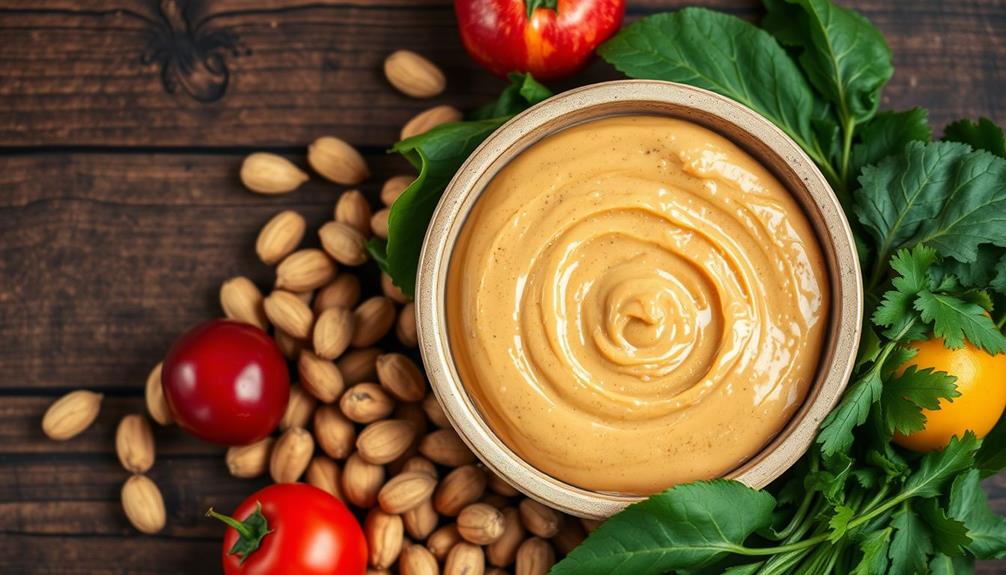
Raw foods pack a powerful punch when it comes to nutrient density, offering essential vitamins and minerals that support your health.
These foods can also be a part of a balanced investment strategy, similar to how diversifying your portfolio can mitigate risks associated with cryptocurrency investments, such as avoiding high-pressure sales tactics.
You'll find plenty of antioxidants in fruits, vegetables, nuts, and seeds, which help combat oxidative stress.
Plus, the dietary fiber in these foods keeps you feeling full while promoting healthy digestion.
Nutrient Density Advantages
Many people find that incorporating raw foods into their diet, such as raw peanut butter, offers significant nutrient density advantages.
When you choose raw peanut butter, you're not just enjoying a tasty spread; you're also fueling your body with healthy nutrients that can aid in various aspects of health. Additionally, much like the meticulous approach taken in best practices of software quality assurance to guarantee quality, choosing high-quality raw peanut butter can lead to better health outcomes.
Here are a few reasons to evaluate adding it to your diet:
- High in Healthy Fats: Raw peanut butter is packed with monounsaturated fats that support heart health and may help reduce the risk of chronic diseases.
- Supports Digestive Health: With its higher fiber content, raw peanut butter promotes digestive health and helps you feel satisfied, which is great for weight management.
- Cleaner Nutritional Profile: Unlike many processed peanut butters, raw peanut butter avoids unhealthy additives, giving you a cleaner option that's rich in vitamins and minerals like magnesium and vitamin E.
Antioxidant-Rich Components
When you choose raw peanut products, you're tapping into a treasure trove of antioxidants that can greatly benefit your health.
Raw peanuts are packed with powerful compounds like resveratrol and flavonoids, which help combat oxidative stress and protect your cells from damage. Incorporating raw peanuts into your diet can considerably enhance your antioxidant intake and contribute to a balanced diet rich in fruits, vegetables, and whole grains.
Unlike cooked foods, which often lose their antioxidant content through preparation, raw foods maintain higher levels of these essential nutrients.
One standout component is vitamin E, crucial for safeguarding cell membranes against oxidative damage. This nutrient supports your body's defense against chronic diseases by reducing inflammation and boosting immune function.
Dietary Fiber Benefits
Dietary fiber plays an essential role in promoting digestive health and overall well-being. When you include raw foods in your diet, you're not just enjoying their fresh taste; you're also reaping significant health benefits. Fiber is abundant in fruits, vegetables, nuts, and seeds, which are vital for maintaining gut health and preventing constipation.
Consider these benefits of dietary fiber from raw foods:
- Supports Weight Management: High fiber content helps you feel full longer, making it easier to manage your weight.
- Reduces Chronic Disease Risk: Regular fiber intake can lower the risk of chronic diseases, including type 2 diabetes and certain cancers.
- Enhances Heart Health: Soluble fiber helps regulate blood sugar and lower cholesterol levels, promoting a healthier heart.
Aiming for 25 to 30 grams of dietary fiber daily is essential, especially if you're following a vegetarian diet. Incorporating a variety of raw foods not only meets this recommendation but also provides essential vitamins and minerals to boost your overall health.
Embrace the power of dietary fiber to improve your well-being!
Alternatives to Peanut Butter
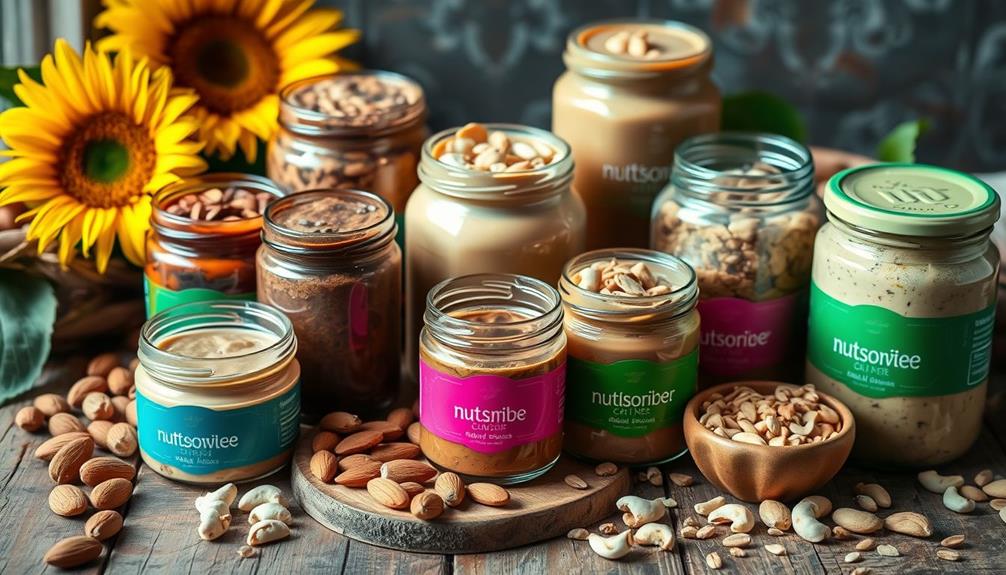
If you're looking for a tasty spread without peanut butter, there are plenty of nutritious alternatives to explore. Raw cashew butter is a fantastic option, packed with copper, manganese, magnesium, and phosphorus—essential nutrients for your health.
Almond butter is another popular choice, loaded with vitamin E, calcium, potassium, and iron, all of which support heart health and bone strength.
You might also want to try tahini, made from ground sesame seeds. It's a versatile alternative perfect for dressings and sauces, though it mightn't work for a classic peanut butter and jelly sandwich.
If allergies are a concern, sunflower seed butter offers a similar taste and texture to peanut butter while being allergy-friendly. It's rich in vitamin E and healthy fats, making it a nutritious choice.
Lastly, consider raw hazelnut butter for a flavorful twist. It provides healthy fats, vitamins, and minerals while being lower in allergens compared to peanut butter.
With these alternatives, you can enjoy delicious spreads that cater to your health needs while keeping your diet varied and nutritious.
Incorporating Raw Peanut Butter
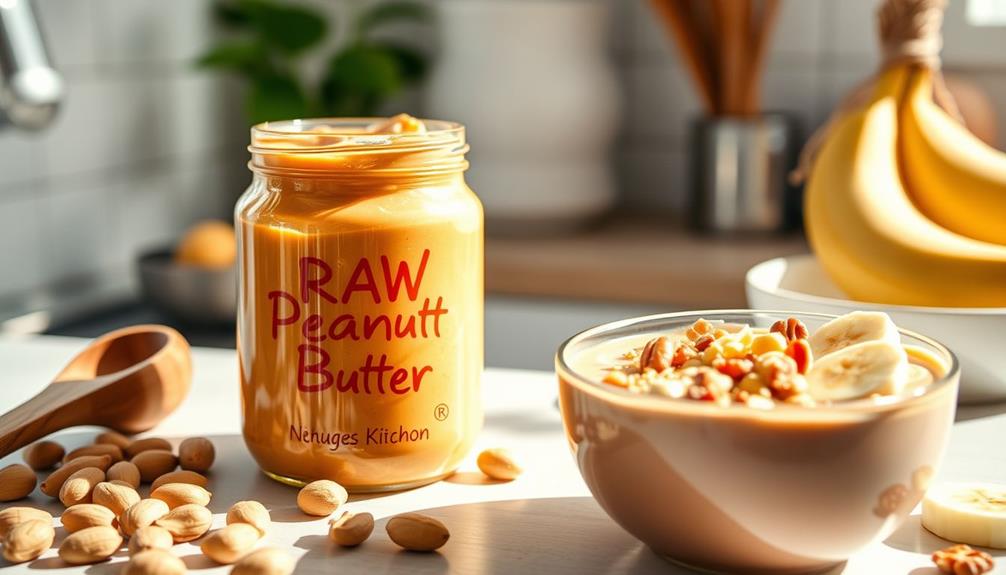
Incorporating raw peanut butter into your meals can be a delicious and nutritious way to enhance your diet. This creamy spread, made from raw peanuts, retains more nutrients and enzymes compared to its roasted counterparts.
However, it's important to be aware of the potential health risks associated with aflatoxin contamination from Aspergillus flavus.
To enjoy raw peanut butter while maximizing your nutrient intake, consider these pairing ideas:
- Spread it on apple slices for a satisfying snack.
- Use it as a dip for crunchy celery sticks.
- Blend it into smoothies for added creaminess and nutrition.
When you choose raw peanut butter, make sure to source high-quality peanuts to minimize contamination risks.
Keep in mind that raw peanut butter has a shorter shelf life and should be stored properly to prevent rancidity. Incorporating it into a balanced diet of raw foods can enhance your overall health.
Just remember to enjoy it in moderation and be aware of any potential health risks. By doing so, you can savor the rich flavor and benefits of raw peanut butter while maintaining a nutritious lifestyle.
Ethical Considerations in Raw Diet

Many people who embrace a raw food lifestyle do so not just for health benefits, but also for ethical reasons. You might find that ethical sourcing of ingredients is a key principle, emphasizing organic and locally sourced produce to minimize environmental impact. This approach aligns with a plant-based diet, where reducing reliance on animal products supports sustainable agricultural practices.
As you navigate this lifestyle, consider how your choices reflect your values. Many raw food practitioners actively promote animal welfare by excluding processed animal products, believing in the ethical treatment of animals. By focusing on plant-based foods, you contribute to a system that prioritizes compassion and sustainability.
Moreover, the raw food community often advocates for practices that lower carbon footprints. This includes consuming seasonal and minimally packaged foods, which can further reduce your environmental impact.
Additionally, avoiding processed foods not only aligns with ethical standards but also helps steer clear of exploitative labor practices often associated with their production.
Tips for a Balanced Raw Diet
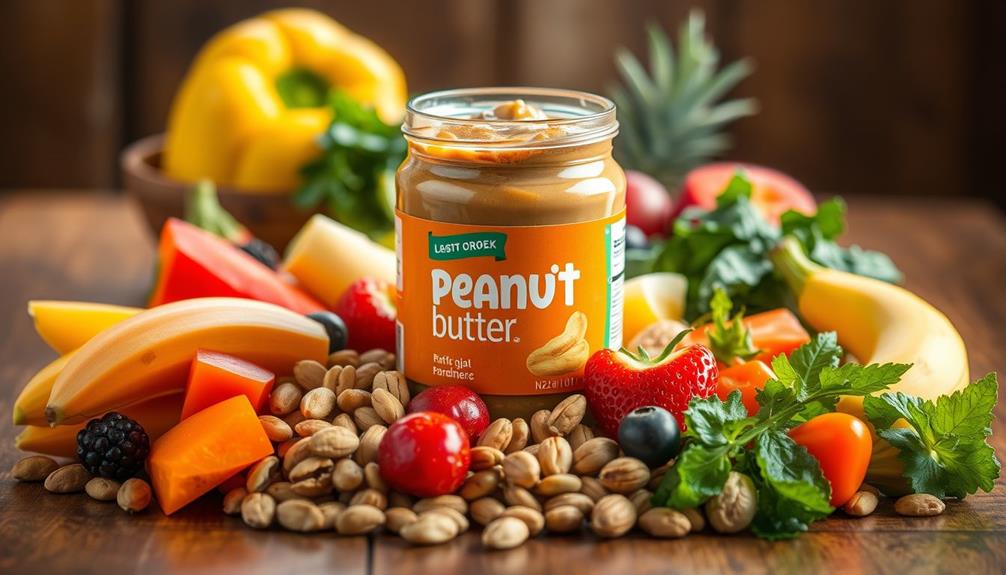
How can you guarantee your raw diet is both balanced and enjoyable? Start by focusing on incorporating a variety of raw foods into your meals. Aim for 75 to 80 percent of your diet to consist of fruits, vegetables, nuts, seeds, and sprouted grains. This diversity guarantees you get the essential nutrients your body needs.
Here are some tips to keep your raw diet balanced:
- Meal Planning: Take time each week to plan your meals. This organization helps prevent nutrient deficiencies and keeps your diet interesting.
- Preparation Techniques: Use soaking, sprouting, and dehydrating methods. These enhance the digestibility and nutrient availability of your raw foods.
- Consult a Nutritionist: Getting personalized advice can help you navigate potential health risks and guarantee you're meeting all your nutrient needs, including protein, vitamin B12, iron, and calcium.
Frequently Asked Questions
Is Peanut Butter Considered Raw Food?
Peanut butter isn't typically considered raw food because it's often made from roasted peanuts and includes additives. If you want raw options, look for homemade versions using raw peanuts, but be cautious about sourcing them. Is hummus a raw food? The answer depends on how it’s made. Traditional hummus is made from cooked chickpeas, making it not a raw food. However, you can make a raw version of hummus using sprouted chickpeas and raw tahini. Just like with raw peanut butter, it’s important to carefully source and handle the ingredients to ensure they meet your standards for raw food.
What Are Considered Raw Foods?
Raw foods include fresh fruits, vibrant vegetables, crunchy nuts, and wholesome seeds. They're unprocessed, retaining nutrients and enzymes. You'll enjoy their natural flavors while supporting your health and embracing a sustainable, ethical lifestyle.
What Are 10 Raw Foods?
You can enjoy raw foods like fresh fruits, leafy greens, nuts, seeds, sprouted grains, avocados, cucumbers, carrots, bell peppers, and fermented options like kimchi. They're nutritious, delicious, and perfect for a healthy diet.
Is Peanut Butter an Inflammatory Food?
You might wonder if peanut butter causes inflammation. It can, especially if it's roasted or contains added sugars and oils. However, moderation and choosing raw varieties can help reduce potential inflammatory effects on your body.
Conclusion
In your quest for a pure raw food diet, you might find it ironic that peanut butter—a beloved staple—could be more processed than you thought. While you aim for health, those once-innocent peanuts might hold hidden risks if eaten raw. So, as you savor that creamy spread, remember: the path to wellness can sometimes lead you back to the very kitchen where cooking and processing are deemed guilty. Embrace balance, and maybe opt for those roasted nuts instead!





